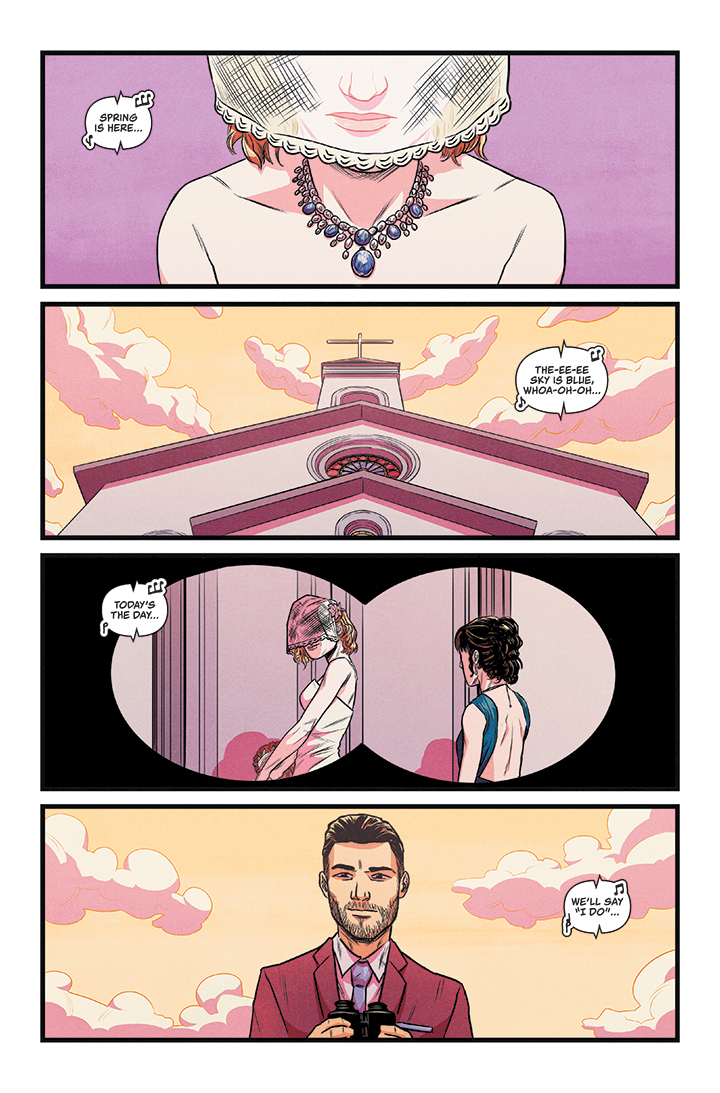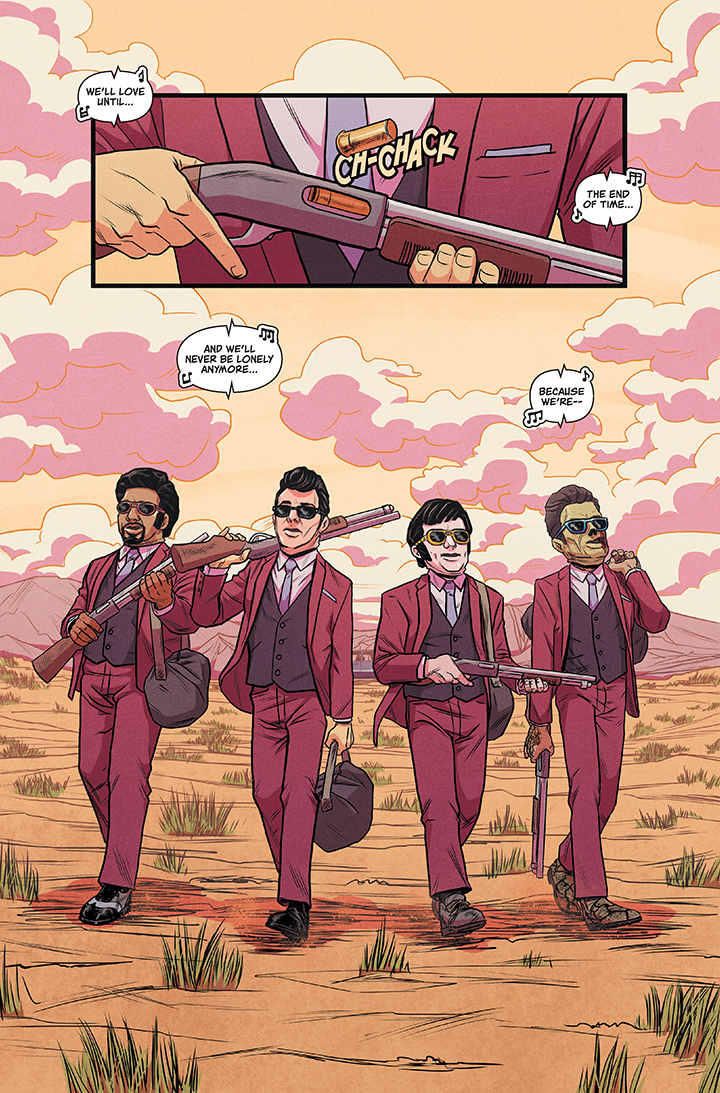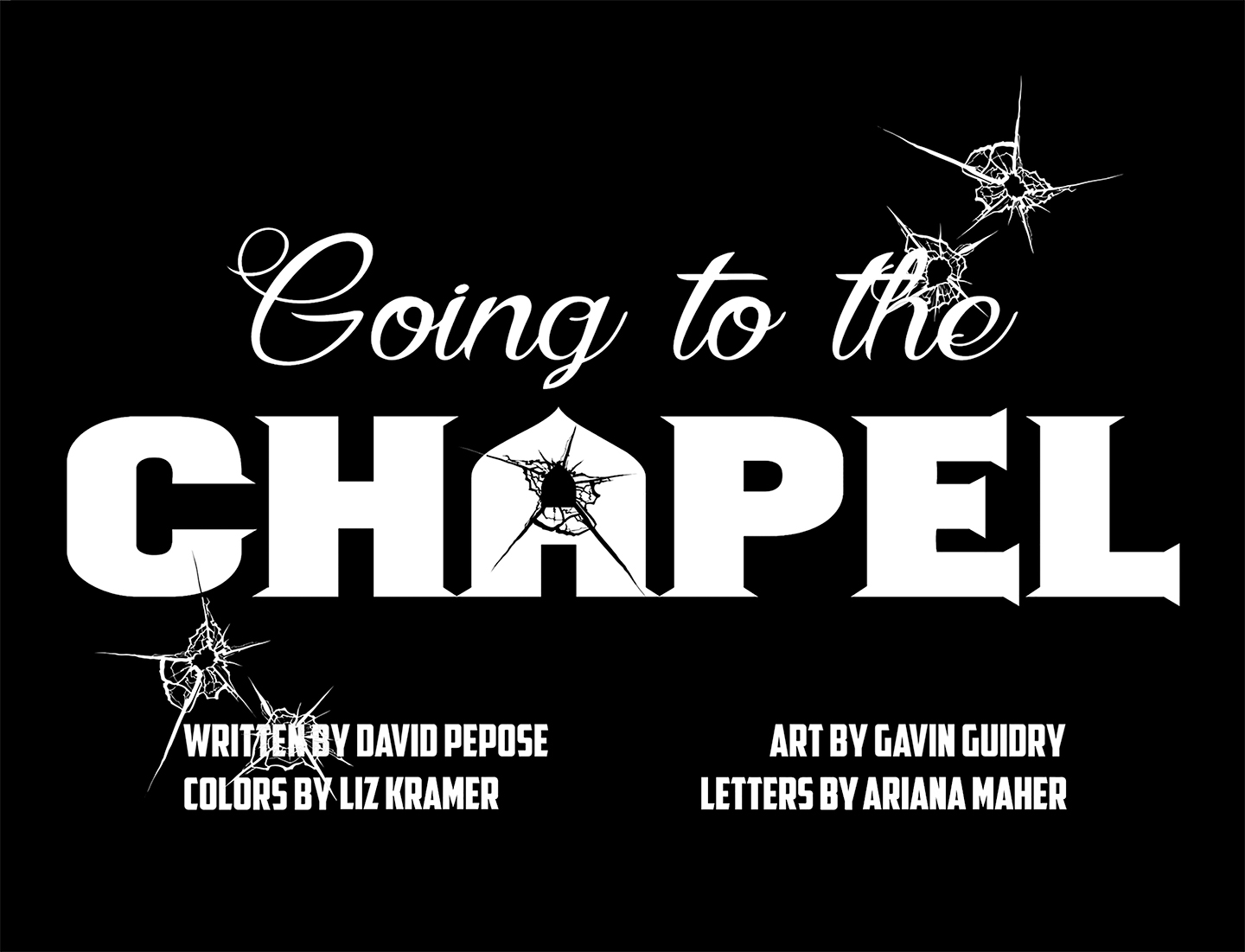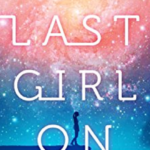YOU ARE CORDIALLY INVITED TO THE HOSTAGE SITUATION OF THE CENTURY IN ACTION LAB: DANGER ZONE’S “GOING TO THE CHAPEL”
ROGUES PORTAL: A 250 million dollar wedding heist, an obnoxious rich family, and an armed gang of bad Elvis impersonators; there just has to be a good story behind how the idea for Going to the Chapel came together.
DAVID PEPOSE: Yes, there is! (Laughs) Going to the Chapel was inspired by my truly disastrous turn as best man at my oldest friend’s wedding — particularly the bachelor party I was supposed to plan. Everything that could go wrong, did go wrong — the Airbnb was trashed on arrival; the sumo set I rented couldn’t fit in the backyard, because it was essentially set at a 45-degree angle; a couple of groomsmen backed out at the last second because they didn’t want to pay their share of the fees; and I wound up being hospitalized 48 hours before the event with a kidney stone, meaning I couldn’t actually make my flight to this getaway I had been planning for weeks. (Laughs) It was… quite a mess, especially trying to troubleshoot it all on painkillers over the phone.
But while this Hindenburg was going down, I thought to myself, “Thank God this didn’t happen during the wedding…” And then, of course, the very next thought I had was, “What if it did?” What would be the truly most cursed wedding of all time? At first, I thought it would be if the father of the bride hired leg-breakers to “persuade” the groom to call it off — which was the initial inspiration behind the Bad Elvis Gang — but then I realized the more harrowing story would be just if the bride herself started having second thoughts. There’s a really dramatic emotional arc in deciding what your future is supposed to look like — Going to the Chapel might involve a wild police standoff and a $250-million-dollar necklace, but the real score behind this series is about a bride trying to find her true happily ever after.
RP: After working on such a dark, heavy story in Spencer & Locke, what were the challenges you faced switching gears for Going to the Chapel?
DP: To be honest, the switch in tone was actually the easiest part for me — the biggest challenge I have writing Spencer & Locke is striking that balance between dark and oppressive while still honoring some very real-world issues, so being able to drop my guard and really lean into the humor and dysfunction with Going to the Chapel was part of what made this project so appealing to me. It’s the same sensibilities in terms of juggling action, humor, and heart, but this book has a warmth and sense of fun to it that I think it’s really special.
The biggest challenge about Chapel as a series has to be juggling the cast — the first goal I had with this series, beyond trying to find a way to tackle romantic comedies in a unique way, was I wanted to expand and diversify my cast beyond the pretty stripped-down ensemble from the original Spencer & Locke So with Going to the Chapel , we’ve got 15 people running around — and all trapped in the same location, no less — so I did a lot of rewrites in the treatment stage to make sure we had all of our moving parts accounted for. With Spencer & Locke, scene changes were part of made the story read as fast-paced as it did, but with Chapel, we had to flex some very different muscles to keep the story feeling cohesive.
RP: The Anderson family is certainly a colorful cast of characters. They bring to mind other dysfunctional rich families like the Bluths–despite being terrible people, there’s an indelicate appeal to them. Is this family dysfunction merely for the sake drama, or is there something deeper you’re looking to explore?
DP: Definitely — I think the Andersons are really the human element of Going to the Chapel, because I think we can all relate to being trapped in a room with your weird, extended family, right? The stories I could tell you about my parents, it would absolutely feel like a hostage situation. (Laughs) The thing is, I was really nervous about having so many characters to account for in this series, but I wound up discovering some really fun arcs for each of the Andersons individually, as well as seeing the family get to grow and evolve as a group.
Some of this also comes from my two big inspirations behind this series — Dog Day Afternoon and Death at a Funeral — which centered around dysfunctional people being stuck in a particularly harrowing situation (a hostage situation at a bank, and reconnecting during a patriarch’s funeral, respectively). There’s a lot of comedy to be mined from seeing people twist themselves in knots trying to act “normal” in a situation that is the furthest thing from normal, and I felt it was really important to lean into that comedy to keep this series from feeling too bleak or oppressive. I wanted Going to the Chapel to be the ultimate date-night comic, and I think the Andersons are key to not just maintaining our tone, but our deeper themes as well.
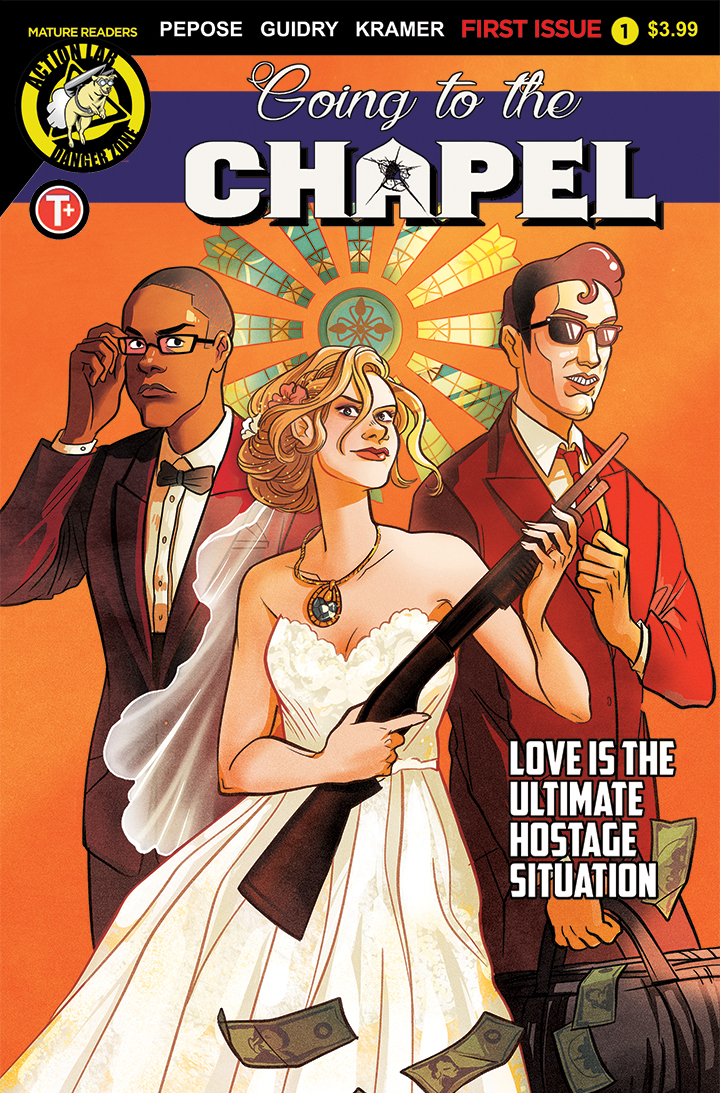
RP: Emily may be having honest doubts about the wedding, but, of course, she’s got some secrets of her own. In the first issue, there isn’t much to her beyond having cold feet; what more can you tell us about this badass bride who, on the cover, looks ready to take some names?
DP: Emily Anderson is the bride at the center of this wedding from Hell, and she’s also the heroine of our story. She loves her fiancé Jesse, but she also finds herself wondering if he’s the Mister Right for her — and it’s that case of cold feet that spins the Bad Elvis Gang’s simple robbery scheme into a full-blown hostage situation. With the Elvises on one side, the Andersons on the other, and the police outside looking to shoot first and ask questions later, Emily is going to wind up blurring the lines a bit — she’s going to have to play one side against the other to not just get everybody out in one piece, but to figure out exactly what she wants her future to look like. And given that she knows her wedding inside and out, Emily’s going to find some very creative avenues to save the day — that is, if her dysfunctional family doesn’t screw everything up first.
The thing is, I felt it was really important to have Emily be the protagonist of this series — in particular, I feel like the fear of commitment is something that’s usually treated as a male-only concern in pop culture, whereas I think women have a lot more to risk when they’re deciding to settle down with someone. And on top of that, I think pop culture as a whole still has a tough time envisioning ways to have women be the leads of a badass action story — for every Ripley, Sarah Conner or Wonder Woman out there, we’ve got a dozen forgettable male-heavy shoot-‘em-ups. But action shouldn’t be a male-dominated genre any more than romcoms should be “exclusively” for women, whatever that means — so I wanted to make a statement with Going to the Chapel and with Emily as our protagonist, in particular, to try to deliver a book that would upend preconceptions and draw in as many readers as possible.
RP: You may be billing this as Die Hard meets Wedding Crashers, but all I see is Kill Bill. From Emily’s Beatrix Kiddo vibe to the four-armed Elvis’ walking a line into the chapel, it’s hard not to see the comparisons. But nothing feels too forced. How do you avoid the pitfalls when drawing inspiration from pop culture?
Boy, that’s a great question. For me, so much of that is just based on instinct rather than anything deliberate — my general process is to just consume as much pop culture as I can, from movies to music to TV, and just see what kind of images stick out in my mind as a result. Probably the reason it feels natural is because I’ve just got so much stuff to shove into the blender that nobody but me can spot all the influences! (Laughs)
Writing is a little like a Rorschach test with me — so much of my writing is about reacting to things almost unconsciously, where I’m just figuring out whether or not a scene works just by feeling rather than anything else. It’s sort of like trying to find your bed in a dark room, where there’s junk on the ground — you go a little too far in one direction, there’s a pile of laundry, where you go too far in another direction, you’re stepping on a Lego, your cell phone, or your dog. (Laughs) I might have told you too much about the way I live, but it’s feeling out that path where there’s no impediment that’s kind of how I try to navigate my writing process.
RP: Since we’re talking Tarantino, any personal favorites you always go back to for inspiration?
DP: My favorite Tarantino movies are the classics — Reservoir Dogs and Pulp Fiction. I think the latter is where Tarantino really perfects that signature combination of over-the-top violence, killer one-liners, and wild structural formats. I think those are also my favorites because they’re the most street-level, the most down-to-earth — don’t get me wrong, I’ve enjoyed Kill Bill, Inglorious Basterds, and Django, but there’s something all the more exciting about his original stories, with vulnerable, human characters who could very well lose their lives at any moment.
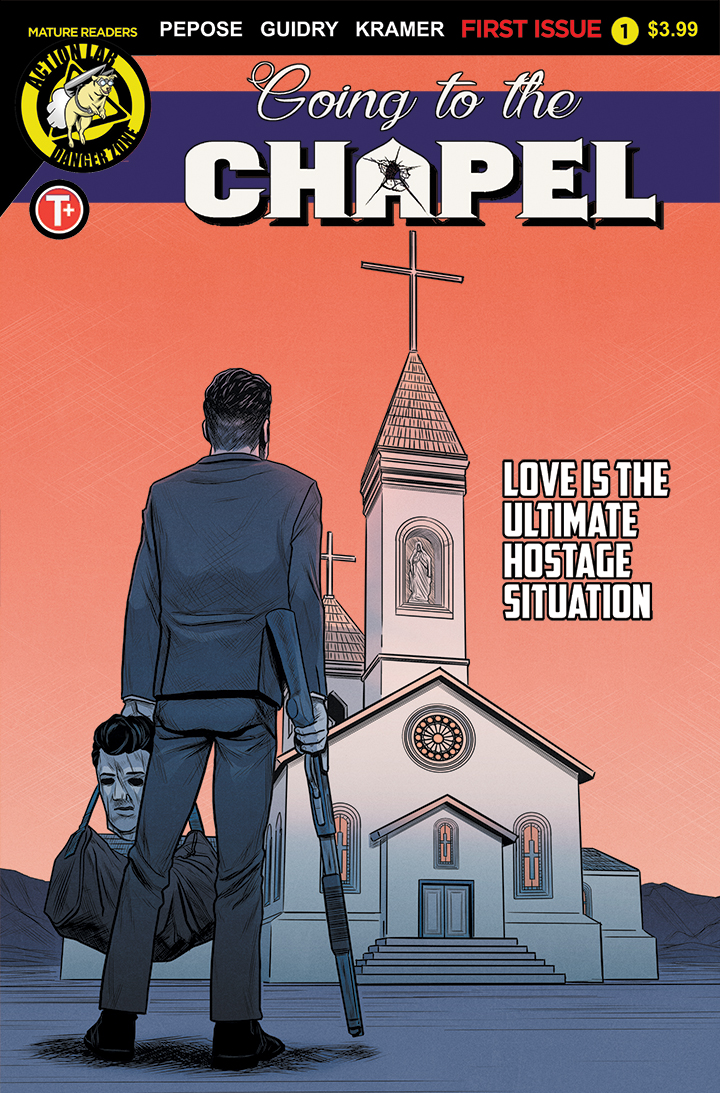
RP: Gavin Guidry and Liz Kramer knock this one out of the chapel, the colours, in particular, create the perfect afternoon atmosphere and give the comic its signature style. Did you let them do their thing, or did you have a specific look in mind for Going to the Chapel?
DP: They’re really incredible, aren’t they? I was immediately taken with Gavin’s style when I first read his indie breakout book The Night Driver — I knew Going to the Chapel was going to require a combination of comedy, expressiveness, and action, and you could tell just from that single issue that Gavin would be able to deliver. He’s got this style that I say is a cross between Jamie McKelvie and Doc Shaner — it’s very clean, but you know exactly what these characters are thinking from a mile away. He and I talked a lot just during the layout and thumbnail stages, but Gavin really did a terrific job selling the unique tone of our series — you can really read this and see how it could go from comedy to action at the drop of a hat.
Our colorist Liz Kramer, meanwhile, is our secret weapon — mark my words, she’s going to be the next Laura Martin. From my earliest days in the industry as a DC Comics intern, it was instilled in me early that a colorist will make or break your book — a good colorist can elevate any artist, while a bad colorist can tank even the biggest A-lister. And Liz isn’t a good colorist — she’s a great one. We talked a lot about Patricia Martin’s work on Secret Weapons, and Matt Wilson’s work on Black Widow, but Liz really took those foundations and ran with them. She’s got this beautifully textured style that really gives Going to the Chapel a very unique vibe, one that sells our action-romcom concept nicely.
RP: If you’ll indulge my nitpicking, why was a 250 million dollar sapphire necklace loaned for a wedding in the middle of nowhere without any security detail whatsoever?
DP: The museum wanted to bring security, but after two hours of Emily’s financier father Arthur screaming about how the guards would clash with the wedding photos, the museum finally just gave in. He has a very specific aesthetic about this wedding. (Laughs) No, but seriously, we’ll answer that question in Issue #2 — long story short, rich people can still make sloppy mistakes.
RP: As usual, any other projects in the pipe you’d like to share with our readers?
DP: Sure! I’m wrapping up promotion on my other Action Lab title, Spencer & Locke 2, with the final issue out July 4th week and the trade paperback collection out the first week of August — I’m so proud of how our sequel has come together, and I’ve got fingers crossed I’ll have some more news to share about that series soon. I’m also hard at work on Grand Theft Astro, my upcoming sci-fi book with Top Cow — I’m rounding the finish line as far as scripts are concerned, and artist Jordi Perez has turned in some fantastic pages so far. I’ve also got a fantasy story that I’m really excited about, and the pages that are trickling in art just fantastic. And then I’ve got a handful of sci-fi and horror pitches that I’m finding homes for, as well as a crime book that, if I can pull it off right, might be the biggest, most ambitious series of my career.
That’s the great part about being an indie comics writer, and the appeal of Going to the Chapel as a whole — comics are kind of the final frontier in pop culture, as far as being able to try new things, to mash up genres in unorthodox ways, and to try to reinvent yourself with every new series. But ultimately, every story I write should be a love story — not only does Emily has to survive a hostage situation to figure out where her heart truly lies, but as a creator, I also have to find something to love about every single story I write, whether that’s juggling a cast of crazy in-laws, finding creative ways to turn wedding gifts into weaponry, or taking a brand-new twist on the rom-com genre. But at the end of the day, finding the love at the heart of your story is the only the thing that matters — because if I can’t find something to love about this story, how could I ever expect readers to take the plunge with me?
Going to the Chapel #1 will be in comic shops September 4th, pre-order codes below:
GOING TO THE CHAPEL #1 COVER A LISA STERLE – JUL191409
GOING TO THE CHAPEL #1 COVER B HOUSE – JUL191410
GOING TO THE CHAPEL #1 COVER C GUIDRY – JUL191411
